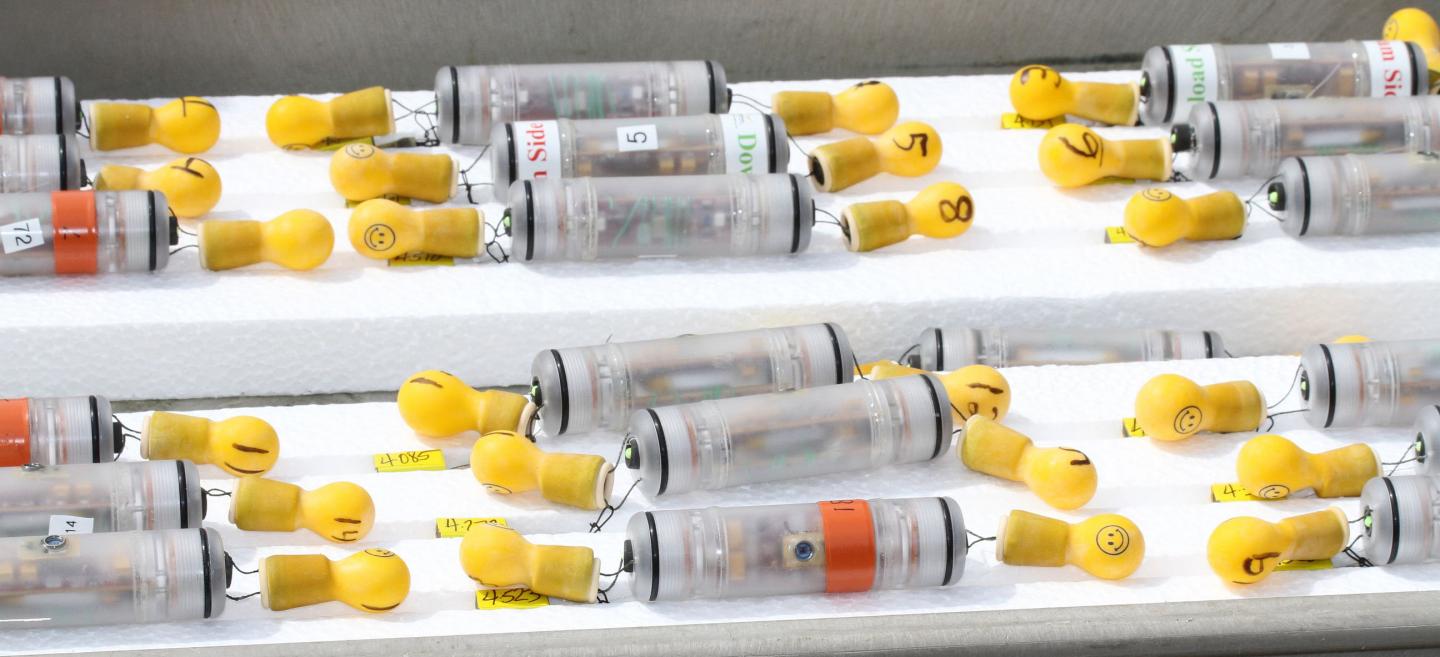PNNL’s autonomous ‘Sensor fish’ and acoustic transmitter licensed by wildlife tracking company ATS

Credit: PNNL
Hundreds of surrogate “fish” will be put to work at dams around the world through an agreement between ATS – Advanced Telemetry Systems – and the Department of Energy’s Pacific Northwest National Laboratory to improve operations and increase sustainability.
PNNL developed the Sensor Fish to understand what happens to fish as they pass through turbulent waters and turbines at hydroelectric facilities. The Sensor Fish is a small autonomous device filled with sensors that analyze the physical stressors that fish, such as juvenile salmon, experience when passing through or around dams.
The technology was recently licensed to ATS through a process known as technology transfer, which enables federally-funded research to be made commercially available.
The sensors provide dam operators and fisheries researchers with accurate, physical measurements such as acceleration, pressure, rotational velocity and orientation, which convey what real fish experience during downstream passage. Each sensor provides roughly 2,000 measurements per second and typically takes less than two minutes to pass through the dam due to the water’s velocity.
“The vast majority of juvenile salmon and steelhead passing through the turbines survive without injury in the Columbia River Basin,” said Daniel Deng, a Laboratory Fellow at PNNL. “Still, we want to understand more about the injuries and mortality that do occur from abrupt pressure changes in dam turbine chambers. The Sensor Fish provides information to help engineers design more fish-friendly turbines going forward.”
Once the Sensor Fish comes out on the other side of the dam, an automatic retrieval system brings it to the surface. Radio signals and flashing LED lights from the Sensor Fish will then allow them to be collected quickly from boats stationed nearby.
The Sensor Fish has demonstrated its value in many field studies, for which Deng’s team has built individual Sensor Fish in their lab at PNNL. Now, with the technology licensed to ATS, the manufacturing process can be streamlined, and more hydropower operators and researchers will be able to put it to use.
“There is a big need for the type of data provided by the Sensor Fish,” says ATS president Peter Kuechle. “Mature hydropower industries in the U.S. and Europe hope to modify operations in order to help fish survive. In Europe, regulations insist on testing for this information, and certainly there’s a need for the data in emerging hydropower projects globally.”
ATS has also licensed two other fish technologies developed at PNNL. The Juvenile Salmon Acoustic Telemetry System (JSATS) and its advanced decoder software that can track fish passage through dams and beyond, and also monitor fish behavior. PNNL developed the JSATS transmitters and battery to be so small it can be injected into young fish — eliminating the need to surgically implant a tag, which puts extra stress on a fish. The JSATS includes the smallest acoustic transmitters in the world. PNNL has also recently developed an even smaller tag technology that allows for research on the tiniest fish including juvenile eel and lamprey.
“This new acoustic fish tag meets the Army Corps of Engineers’ JSATS specifications and weighs less than one one-hundredth of an ounce,” said Kuechle. “The JSATS technology is complementary to our long history offering innovative and cost-effective wildlife tracking products and we’re proud to have supplied the devices to the Army Corps this year for an important study on the lower Snake River.”
PNNL also has developed bigger, rugged tags with larger batteries to enable research on large and long-lived species such as sturgeon. PNNL is working to develop a self-powered tag that would enable long-term monitoring.
PNNL’s tracking and sensing technologies are applicable to a wide range of species, research goals, commercial applications and locations. The laboratory has validated its tracking and sensing technologies with more than 100,000 fish in the U.S., Australia, Brazil, Germany and East Asian countries since 2007. They are also applicable to a wide range of species, research, locations and commercial applications. They are available for testing with small mammals and amphibians.
The development of these technologies was funded over many years by the Army Corps of Engineers, DOE’s Office of Energy Efficiency and Renewable Energy and the Electric Power Research Institute.
###
Media Contact
Susan Bauer
[email protected]
509-372-6083
Original Source
https:/




